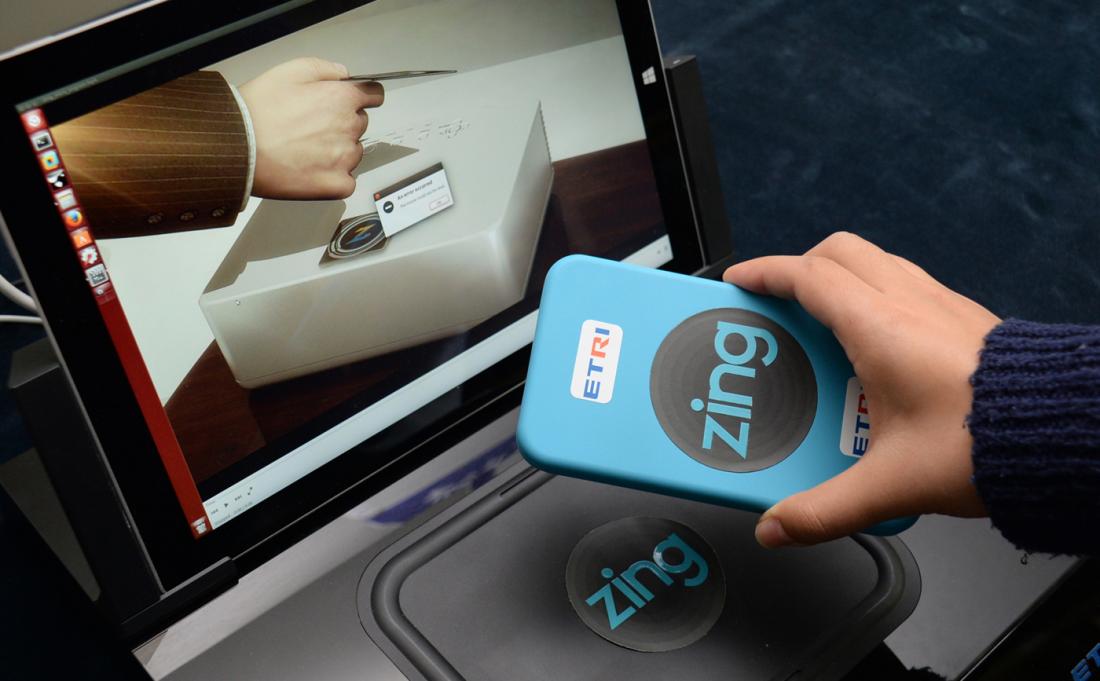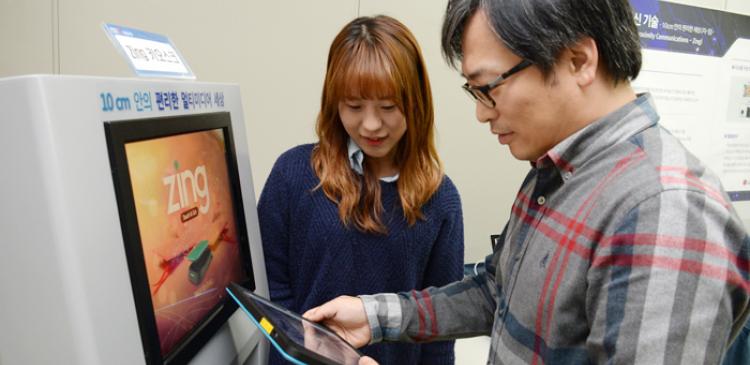South Korea's Electronics and Telecommunications Research Institute (ETRI) has developed Zing, a speedy near field communications(NFC) technology to conveniently transmit and receive several Gbyte of content within a radius of ten centimeters without inconvenience for accessing. Once a device touches the kiosk, Zing can instantly fetch the data the user wants. Compared to NFC, which is utilized only for limited uses such as transportation cards due to the restricted speed of data transmission, this latest technology offers approximately 8,000 times faster speed at 3.5 Gbps, which translates to three seconds for sending a movie of 1 Gbyte.
One of the advantages of this technology is readiness for commercialization based on the low-power and low-complex technology of 100 milliwatts. In addition, broadband communications are available as the technology uses the unlicensed 60 GHz frequency free of charge. In addition to smartphones and tablet PCs, wireless storage devices without a power supply can also be used for instant data transfer, without the need to physically connect them to other devices. Lastly, the use of a secure communications zone better prevents hacking attempts compared to Wi-Fi.
Various applications for airports, daily life, and medical purposes
This technology converts the kiosk's data at the modem through the OOK (On/Off Keying) data transmission method, thereby sending the data through the broadband of 60 GHz. Wireless near field communications are not affected by electronic interference, even when frequencies are re-used. To realize this technology, ETRI developed hardware technologies including modems, RF (radio frequency) transceivers, and antennas; software and system technology; and readers and tag prototypes necessary for data transmission/reception.
With this latest technology, users can download newspapers, magazines, or shopping information at the kiosks installed within an airport; conveniently share video data with others at an office or during meetings; instantly download video clips posted on offline boards; and simply send the downloaded video files to smartphones for sharing.
ETRI is also planning to develop medical devices using the Zing technology. For instance, teeth X-ray images taken at dental clinics will be able to be sent immediately to the dentist's computer within a three-meter diameter.
Since the intuitive interface helps users to send large-scale content to another device within a very short time, wide applications are available for smartphones, cameras, and laptops located around the users. In addition, the technology can be combined with a number of products and services, including smart appliances such as televisions and refrigerators; infotainment systems for vehicles; smart IoT advertisements for shopping malls or streets; and kiosks installed at subway stations.
International standard to contribute to the growing global NFC market
As ultra-fast NFC technology, ETRI's Zing was selected as a candidate for an international standard and is scheduled to be set as a standard during the first half of 2017. ETRI expects that this technology will make a significant contribution to the growth of the global NFC market, and the ETRI researchers participating in this technological development project have applied for a total of 27 patents in and outside Korea, including standard patents, and published 38 papers on this achievement. Currently, ETRI is a supervising institution of the Zing technology and is conducting joint research with three other partner institutions: Korea Electronics Technology Institute and LG Innotek.
After introducing Zing to the public at the KES 2016 held in Seoul in late October, ETRI and its partner developer KOF participated in the K-Global @ Silicon Valley 2016 held in the United States in early November, exploring opportunities to collaborate with local businesses and helping Korean SMEs enter the American market. ETRI also plans to launch new business models in the near future and open new markets through additional technology transfer to relevant companies.




